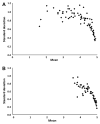A checklist for assessing the methodological quality of studies using transcranial magnetic stimulation to study the motor system: an international consensus study
- PMID: 22647458
- PMCID: PMC4884647
- DOI: 10.1016/j.clinph.2012.05.003
A checklist for assessing the methodological quality of studies using transcranial magnetic stimulation to study the motor system: an international consensus study
Abstract
In the last decade transcranial magnetic stimulation (TMS) has been the subject of more than 20,000 original research articles. Despite this popularity, TMS responses are known to be highly variable and this variability can impact on interpretation of research findings. There are no guidelines regarding the factors that should be reported and/or controlled in TMS studies. This study aimed to develop a checklist to be recommended to evaluate the methodology and reporting of studies that use single or paired pulse TMS to study the motor system. A two round international web-based Delphi study was conducted. Panellists rated the importance of a number of subject, methodological and analytical factors to be reported and/or controlled in studies that use single or paired pulse TMS to study the motor system. Twenty-seven items for single pulse studies and 30 items for paired pulse studies were included in the final checklist. Eight items related to subjects (e.g. age, gender), 21 to methodology (e.g. coil type, stimulus intensity) and two to analysis (e.g. size of the unconditioned motor evoked potential). The checklist is recommended for inclusion when submitting manuscripts for publication to ensure transparency of reporting and could also be used to critically appraise previously published work. It is envisaged that factors could be added and deleted from the checklist on the basis of future research. Use of the TMS methodological checklist should improve the quality of data collection and reporting in TMS studies of the motor system.
Copyright © 2012 International Federation of Clinical Neurophysiology. All rights reserved.
Figures

Similar articles
-
Large-scale analysis of interindividual variability in single and paired-pulse TMS data.Clin Neurophysiol. 2021 Oct;132(10):2639-2653. doi: 10.1016/j.clinph.2021.06.014. Epub 2021 Jul 6. Clin Neurophysiol. 2021. PMID: 34344609
-
Reliability of single- and paired-pulse transcranial magnetic stimulation for the assessment of knee extensor muscle function.J Neurol Sci. 2017 Apr 15;375:442-449. doi: 10.1016/j.jns.2017.02.037. Epub 2017 Feb 16. J Neurol Sci. 2017. PMID: 28320184
-
A Checklist to Reduce Response Variability in Studies Using Transcranial Magnetic Stimulation for Assessment of Corticospinal Excitability: A Systematic Review of the Literature.Brain Connect. 2020 Mar;10(2):53-71. doi: 10.1089/brain.2019.0715. Brain Connect. 2020. PMID: 32093486
-
Strength-Duration Relationship in Paired-pulse Transcranial Magnetic Stimulation (TMS) and Its Implications for Repetitive TMS.Brain Stimul. 2016 Sep-Oct;9(5):755-761. doi: 10.1016/j.brs.2016.04.019. Epub 2016 Apr 28. Brain Stimul. 2016. PMID: 27234142
-
Transcranial magnetic stimulation.Handb Clin Neurol. 2019;160:559-580. doi: 10.1016/B978-0-444-64032-1.00037-0. Handb Clin Neurol. 2019. PMID: 31277876 Review.
Cited by
-
Effects of sleep deprivation on cortical excitability: A threshold-tracking TMS study and review of the literature.Clin Neurophysiol Pract. 2023 Dec 12;9:13-20. doi: 10.1016/j.cnp.2023.12.001. eCollection 2024. Clin Neurophysiol Pract. 2023. PMID: 38223850 Free PMC article.
-
Modulation of intracortical inhibition in response to acute psychosocial stress is impaired among individuals with chronic neck pain.J Psychosom Res. 2014 Mar;76(3):249-56. doi: 10.1016/j.jpsychores.2013.12.001. Epub 2013 Dec 12. J Psychosom Res. 2014. PMID: 24529046 Free PMC article.
-
Differential Corticomotor Excitability Responses to Hypertonic Saline-Induced Muscle Pain in Forearm and Hand Muscles.Neural Plast. 2018 Apr 22;2018:7589601. doi: 10.1155/2018/7589601. eCollection 2018. Neural Plast. 2018. PMID: 29849568 Free PMC article.
-
Combining noninvasive brain stimulation with behavioral pharmacology methods to study mechanisms of substance use disorder.Front Neurosci. 2023 Jul 24;17:1150109. doi: 10.3389/fnins.2023.1150109. eCollection 2023. Front Neurosci. 2023. PMID: 37554294 Free PMC article.
-
Characteristics of motor evoked potentials in patients with peripheral vascular disease.PLoS One. 2024 Apr 25;19(4):e0290491. doi: 10.1371/journal.pone.0290491. eCollection 2024. PLoS One. 2024. PMID: 38662756 Free PMC article.
References
-
- Ahdab R, Ayache SS, Brugieres P, Goujon C, Lefaucheur JP. Comparison of “standard” and “navigated” procedures of TMS coil positioning over motor, premotor and prefrontal targets in patients with chronic pain and depression. Clin Neurophysiol. 2010;40:27–36. - PubMed
-
- Cerqueira V, de Mendonça A, Minez A, Dias AR, de Carvalho M. Does caffeine modify corticomotor excitability? Clin Neurophysiol. 2006;36:219–26. - PubMed
-
- Chen R, Cros D, Curra A, Di Lazzaro V, Lefaucheur JP, Magistris MR, et al. The clinical diagnostic utility of transcranial magnetic stimulation: report of an IFCN committee. Clin Neurophysiol. 2008;119:504–32. - PubMed
Publication types
MeSH terms
Grants and funding
LinkOut - more resources
Full Text Sources

